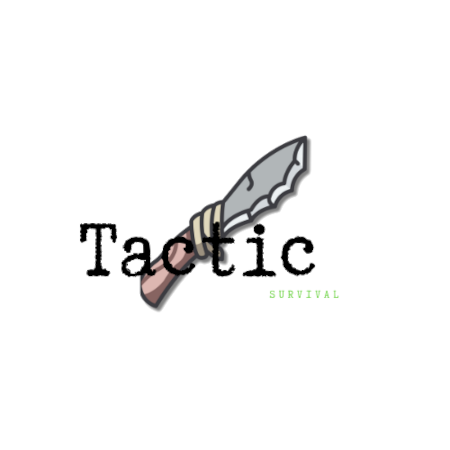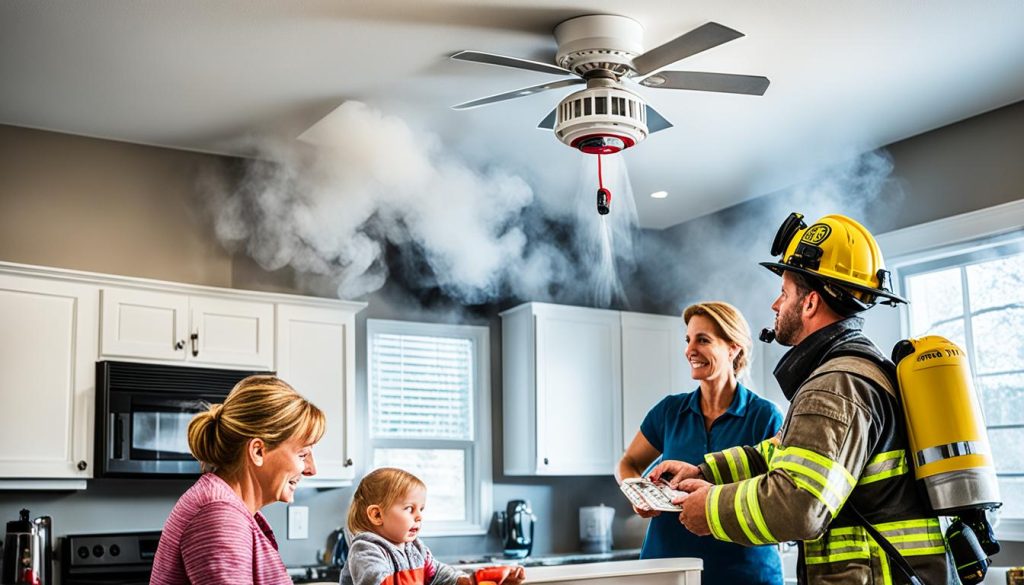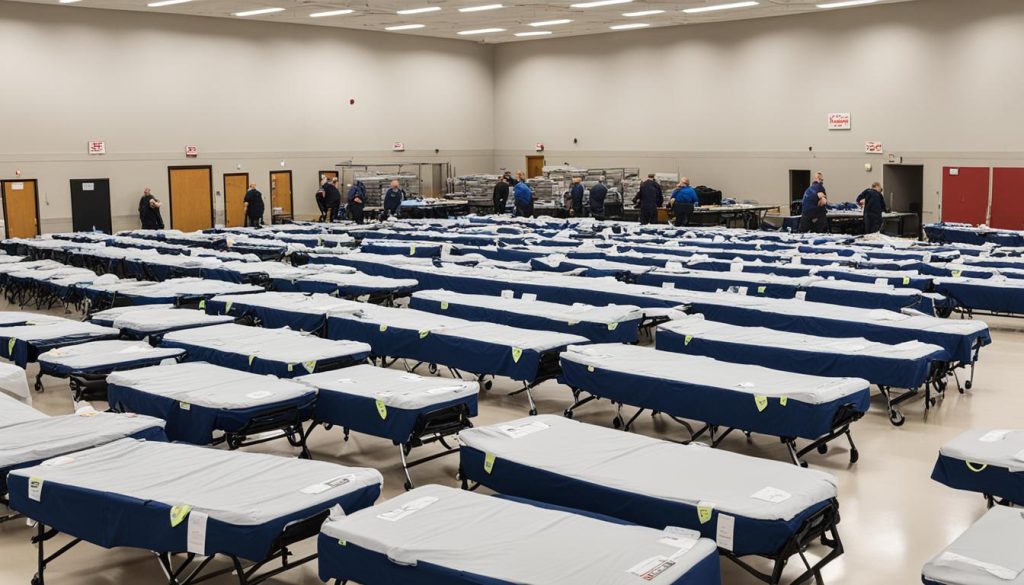Disasters hit millions across the globe every year. These can be natural like hurricanes or man-made such as terrorist attacks. The effect can be huge. Yet, being ready and knowing what to do can make a big difference. It cuts risks and speeds up recovery.
The American Red Cross helps by giving free disaster training to volunteers. These courses teach the full disaster management cycle. Volunteers learn skills needed to lessen emergency impacts and aid the affected.
Key Takeaways:
- The American Red Cross offers free disaster training courses for volunteers.
- The workshops cover the whole cycle of disaster management.
- Volunteers can join various programs to support disaster prevention, response, and recovery efforts.
- Training is available both online and in-person.
- By joining these workshops, volunteers make their communities safer and more prepared.
Join the Local Disaster Action Team
Being part of the Disaster Action Team (DAT) is vital for helping in disasters. They’re the first to respond, supporting people and families hit by emergencies like fires. They work closely with the fire department.
DAT ensures those in trouble find a safe place and get the help they need. By becoming a volunteer, you directly support your community when it’s needed most.
Joining DAT means you’ll get thorough training. This training gives you the skills and knowledge to assist in various ways. Whether helping with shelter or providing comfort, you’ll make a big difference in disaster survivors’ lives.
| Benefits of Joining the Disaster Action Team: | Responsibilities of a DAT Volunteer: |
|---|---|
|
|
Becoming part of the Disaster Action Team lets you help your community in tough times. Whether you’re into disaster response or just want to help, DAT is glad to have you.
This is your start to becoming a key part of the Disaster Action Team. You’ll change lives for the better in times of disaster.
Teach Children About Preparedness
The Red Cross and Disney work together to teach kids how to deal with disasters. The Pillowcase Project brings disaster prep into classrooms all over the U.S. It targets kids in grades 3 through 5, making them ready and strong community members.
Volunteers are vital to making the Pillowcase Project work. They become instructors, guiding kids on important disaster prep steps. This way, children feel empowered and ready.
The course for volunteers covers many topics. It includes an overview of the project, how to teach effectively, and practice training. This ensures volunteers can deliver good education on disaster prep.
The goal is to show kids why getting ready for disasters is crucial. They learn about dangers and how to lower the risks. By teaching this early, volunteers help build a future generation that’s prepared and strong.
They talk about severe weather, home fires, and earthquakes in interesting ways. This keeps kids engaged and teaches them to protect themselves and help others.
“The Pillowcase Project has changed how we teach disaster prep to kids. With fun activities and the pillowcase symbol, learning is made safe and enjoyable. Our volunteers are essential. They help kids protect themselves and their communities.” – [Red Cross Representative]
The Pillowcase Project is more than just lessons. It also gets kids taking charge of preparing their families. Every kid gets a pillowcase to fill with emergency items. This makes preparedness personal and encourages them to teach their families too.
The Red Cross and Disney joining forces is powerful. They use Disney’s appeal to spread the Pillowcase Project far and wide. Kids learn to handle emergencies well, feeling strong and prepared.
The Importance of Youth Outreach
Getting kids involved in disaster prep has big benefits:
- Kids can change their families for the better by sharing what they learn.
- Since they start learning early, they remember how to be prepared.
- It helps kids feel less scared during disasters, lowering their stress.
Implementing the Pillowcase Project
Implementing the Project depends on passionate volunteers. They help kids directly and motivate them to act. This makes communities safer.
Interested in teaching this to kids in your area? Check out the Red Cross website for training info. Help create a prepared world for the next generation.
Participate in the Smoke Alarm Installation Campaign
The Smoke Alarm Installation Campaign aims to keep people safe by placing smoke alarms in homes across the country. Teams made up of Red Cross volunteers, local partners, and fire departments pick areas where people might be at higher risk. They then install these valuable tools. This effort helps improve community safety, making a big difference in preventing fire tragedies.
Setting up smoke alarms is key to staying safe from fires. These alarms detect smoke early, giving you time to get out safely. They’re known to save lives by warning people before fires get out of control.
The Importance of Smoke Alarms
Smoke alarms are a big part of staying safe at home. They’re put on walls or ceilings to watch for smoke. When they sense danger, they sound a loud alarm. This gives everyone a chance to get to safety fast.
By joining the campaign, volunteers help protect those who might not have smoke alarms on their own. They target homes that need these alarms the most. Their work is crucial in keeping everyone safe.
Installation Process and Impact
Teams of Red Cross volunteers, local groups, and fire departments work together to put up alarms. They focus on places with a higher chance of fires or where alarms are missing. This ensures the effort is where it’s needed most.
Volunteers check each home to find the best spots for alarms. They follow strict rules to place and teach residents how to maintain them. This work is key in making homes safer.
This campaign has shown it makes a real difference in keeping communities safe from fires. With more working smoke alarms, homes are better prepared to avoid tragedy. Volunteers are at the heart of this success.
Getting Involved
If you care about making your community safer, consider joining the campaign. Your skills and time can help save lives. It’s a rewarding way to help.
Contact your local Red Cross or check their site to see how you can help. They offer training to make sure you can install alarms well. This is your chance to be a part of a big push to prevent fires and keep people safe.
Getting involved in the Smoke Alarm Installation Campaign means you’re part of something big. It’s a nation-wide effort to prevent fire disasters. Together, we can protect our communities and make them stronger.
Provide Response Services at Shelters
When disasters happen, Red Cross volunteers step up. They provide key help at shelters. These volunteers aid families dealing with floods, hurricanes, and fires. They meet urgent needs and help plan what comes next.
Proper training is key for managing shelters in disasters. The Shelter Fundamentals course teaches vital skills. It shows how to set up, manage, and close a shelter effectively. This training ensures shelter processes run smoothly.
After taking the course, volunteers are ready for many critical roles at shelters. This includes:
- Ensuring access to food and water
- Providing temporary shelter
- Offering comfort and emotional support
- Assisting with registration and documentation
- Coordinating with local authorities and resources
Volunteers’ work directly helps ease disaster impacts. They help people and families recover. Their caring touch makes the shelter a place of hope and support.
Real-Life Impact: Red Cross Shelter Services
“After our house burnt down, we were lost. Red Cross volunteers were there for us with food, clothes, and a place to sleep safely. Their care meant everything to us.” – Evan Thompson, Fire Survivor
Volunteers’ hard work and heart build up communities after disaster. They are a key part of disaster response and recovery. They make sure everyone has a shelter during tough times.
| Benefits of Providing Response Services at Shelters | Role of Volunteers |
|---|---|
| Offers immediate refuge and support for individuals and families | Assisting with registration and documentation |
| Addresses basic needs, such as food, water, and temporary shelter | Coordinating with local authorities and resources |
| Provides emotional support and comfort | Offering comfort and stability in the shelter environment |
| Serves as a resource hub, connecting individuals with necessary assistance | Supporting individuals in planning their next steps |
Deliver Recovery Services
After a disaster, Red Cross caseworkers contact those hit and offer recovery help. They team up directly with people, looking at their needs and making detailed plans for them. Then, they link them with support and resources they require. Their kind and informed work is very important. It helps survivors move through the tough path of starting again after a disaster.
Caseworkers from the Red Cross provide one-on-one help to disaster survivors. They know that everyone’s story is different. So, they thoroughly check to find out what each person needs. This way, they can make plans that specifically support each individual. These plans cover things like finding a home, money help, staying emotionally well, and getting healthcare.
Collaboration is key in recovery planning. Caseworkers work closely with community partners, the government, and other groups. They use their many contacts to make sure survivors get all services and support. This happens as part of a complete recovery plan.
Emotional aid is also a big part of what caseworkers offer. After a disaster, people can feel upset and not sure what comes next. Caseworkers offer a listening ear. They’re there to support and help people move through their emotional troubles during recovery.
Casework and recovery planning by the Red Cross truly makes a difference. Their work helps people and communities get back on their feet long term. Red Cross volunteers are committed and skillful. They help survivors face and beat the challenges, making them stronger to start anew.
Engage Volunteers
Big disasters can lead to more people wanting to help through the CERT program. This program, started by FEMA in 1998, sees a lot of new faces. As a volunteer, your help is key. You can assist in finding new volunteers, placing them in the best spots, and keeping track of their work. You can also make sure they feel appreciated.
Getting new volunteers is vital for a strong team. To do this, share what CERT offers and its training chances. This brings in new faces ready to help their community in tough times.
After people show interest, it’s important to find the right spot for them. Matching their skills and what they like to do with the right tasks is crucial. This way, their help is used well and everyone benefits.
Volunteers deserve thanks for their hard work. Showing you value them keeps them motivated. You can thank them, share their wins, host events in their honor, or showcase their work in many ways.
Volunteers, like those who fight fires, are a huge help in disasters. They boost what we can do, especially where resources are low. Supporting volunteers helps build a strong response team for when trouble comes.
It’s also key to respect the cultural differences among volunteers. Training should focus on this for those from different places. A good response includes everyone and cares for their unique needs.
Dealing with volunteers who show up without being asked needs a plan. Make sure they are safe and useful by giving them the right tasks and training. Good communication is important to keep everything working smoothly.
Once volunteers finish their work, help them check out properly. This involves checking how they are doing health-wise. Providing support when needed is part of taking care of our volunteers.
Assessing how things went with the volunteers is important too. After they help, look back to see what could be better. Learning from these reviews makes our response team even stronger for next time.
| Common Volunteer Roles in Rural Areas | Description |
|---|---|
| Emergency Medical Services (EMS) | Providing medical assistance and support during emergencies. |
| Healthcare Providers | Offering healthcare services to individuals in need. |
| Volunteer Police Service | Assisting law enforcement agencies with maintaining order and responding to emergencies. |
| Medical Reserve Corps | Supporting public health efforts during emergencies, such as vaccination campaigns and medical surge support. |
| Fire Corps | Assisting fire departments in firefighting operations and providing support services. |
Conclusion
Disaster preparedness is vital for strong communities. The American Red Cross offers many free courses for volunteers. These courses teach important skills for helping during disasters.
Volunteers are key in the Disaster Action Teams. These teams are the first to help in community emergencies. They give immediate support to those affected. Volunteers also work on the Smoke Alarm Installation Campaign. This campaign installs smoke alarms in homes to keep people safe.
The Red Cross’s Shelter Fundamentals training is also available for volunteers. This course teaches how to set up and close a shelter during a disaster. Volunteers provide support and help survivors recover. They offer emotional support and crisis help across the U.S.
Vounteers enhance community safety through their efforts. They make up over 90 percent of the response teams. This includes helping in almost 70,000 disasters yearly. Their hard work ensures that those hit by disasters get the necessary help to move forward.


